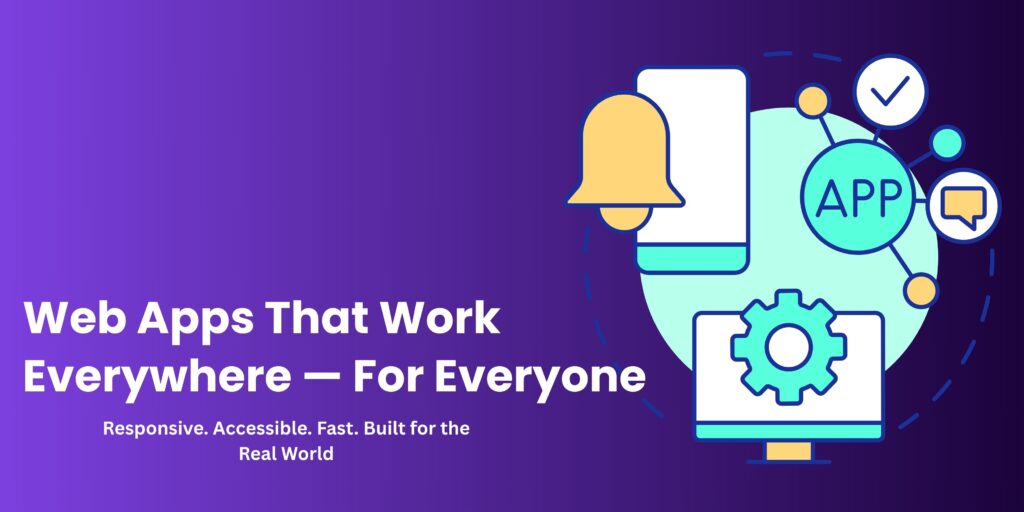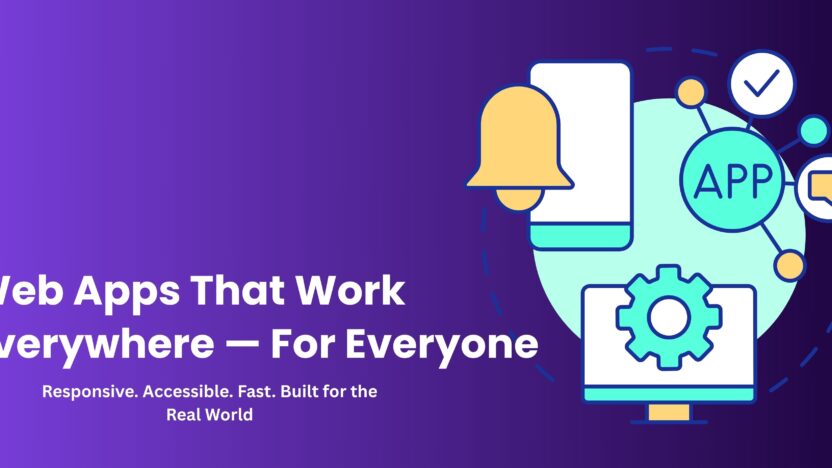
Did you know more than half of all web traffic now comes from mobile devices? That means your web app can no longer be built just for desktops. It has to work well on everything, phones, tablets, laptops, smart TVs, and more.
At the same time, you can’t forget the users. Some may have slower internet. Others may use screen readers or prefer large text. Some might be tapping with fingers instead of clicking with a mouse.
To reach them all, you need to think smart and build with care.
In this guide, you’ll learn how to design web apps that fit every screen and serve every user. We’ll keep things real, clear, and straight to the point.
Let’s get started.
Why It Matters to Design for All Devices and All People
Web apps today are not just used by tech experts. They’re used by everyone—students, older adults, people with disabilities, people on the go, and even people offline.
And here’s the truth:
If your app loads slow or looks messy on a phone, people will leave.
If it’s hard to read or click, they won’t stick around.
If someone can’t use it with a keyboard, you’ve lost a user.
A well-designed web app can grow your business, boost engagement, and improve trust. A poor one can do the opposite.
So, the goal is simple: Build a web app that just works. Anywhere. For anyone.
Make It Responsive from Day One
Responsive web design is not just a buzzword. It’s a must-have.
It means your app changes its layout based on screen size. So whether someone uses a phone or a laptop, they get a clean, easy-to-use interface.
What to focus on:
- Use flexible layouts, not fixed widths
- Let images resize based on screen
- Use simple fonts that read well everywhere
- Keep buttons big enough to tap on phones
- Test your app on all devices, not just one
Start small — design for mobile first, then scale up. That way, you make sure your app stays simple and focused.
Go With the Flow of PWAs
PWA stands for Progressive Web App. It’s a modern way to build web apps that feel like native mobile apps but still work in a browser.
Think of it as giving your app superpowers. A PWA can work offline. It can load fast. It can send alerts. It can be saved to the home screen.
What to include in a PWA:
- Load parts of the app even when offline.
- Show updates without full page reloads.
- Let users add the app to their home screen.
- Use caching to load faster each time.
Many big brands are now turning to PWAs. It keeps users happy and brings them back more often.
Follow the Path of Universal Design
Universal design means building for all kinds of people, not just the average user.
It doesn’t only help people with disabilities. It helps everyone. Older users, people who are tired, or even someone holding a baby with one hand.
Simple ways to use universal design:
- Use easy-to-read fonts and good color contrast.
- Don’t rely only on color to show meaning.
- Avoid small text and tiny buttons.
- Add space between touchable areas.
- Keep navigation simple and clear.
If a feature feels tricky or confusing, simplify it. Make it easier. That’s what universal design is all about.
Make Accessibility Part of the Plan
Accessibility is often skipped in early stages. That’s a mistake.
Over 1 billion people in the world have some form of disability. Many use screen readers or special tools. If your app doesn’t support them, they can’t use it.
Make your app more accessible by:
- Adding text labels to every button and image
- Using headings correctly (like H1, H2, H3)
- Making sure every function works with a keyboard
- Checking color contrast and font size
- Avoiding auto-play sound or videos
There are tools like Lighthouse or axe that help you find and fix problems. Run them often. Fix what you find.
Accessibility is not just a legal checkbox. It’s respect.
Keep It Fast and Light
Nobody wants to wait. A slow app feels broken.
If your app loads in 5 seconds or more, you may lose half your users. That’s the harsh truth.
Here’s how to speed things up:
- Compress images without losing quality.
- Load heavy parts only when needed.
- Clean up messy or unused code.
- Avoid too many scripts and third-party plugins.
- Use browser caching the smart way.
Also, always test your app on slow networks. If it works there, it’ll fly everywhere else.
Speed is part of the experience. Don’t ignore it.
Don’t Forget the Backend
A solid backend makes everything smoother. The backend handles data, user actions, and connecting your app to servers.
If it’s slow or weak, your whole app will feel broken.
Good backend development services can help build an API that’s fast and safe. You’ll need that if your app grows or gets many users at once.
Also, make sure your backend can support things like login, payment, and notifications. These parts often make or break the user experience.
Real-World Wins from Smart Web App Development
A company that offered delivery tracking had a desktop-only system. It was clunky and slow.
They hired a ui ux design services company to rebuild the app. They also chose to hire javascript developers skilled in PWA and accessibility.
The result?
- Mobile users went up by 40 percent
- Bounce rate dropped by 25 percent.
- The app now works offline and loads faster.
- The accessibility score jumped to nearly 100 percent.
It shows what smart design can do.
Simple Steps You Can Follow Today
Here’s a quick checklist for you:
- Use responsive web design from the start.
- Turn your app into a PWA.
- Keep layout and language simple for universal design.
- Follow top rules for accessibility.
- Use clean, fast code and test on all networks.
- Choose strong backend development services.
- Plan with real users in mind, not just devices.
- Hire Javascript developers who know modern tools.
- Only use website application development tools that scale.
- Keep testing, keep improving.
Every step counts. Do it right, and your app will shine.
Final Words
The best apps don’t just look good. They feel right. They work fast, they work everywhere, and they work for everyone.
When you build your next web app, keep users and devices in mind from the beginning. Plan for slow networks. Think about people using screen readers. Design with care.
Web app development is not just about code. It’s about people.
So, take the time. Test. Improve. Make it better.
The result? App users love it. And an experience they’ll remember.


